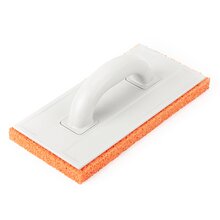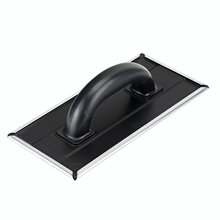
Choosing the right float is crucial when achieving a flawless render or plaster finish. Whether you're working with silicone render, monocouche, or plaster, each float has a specific purpose to help you achieve a smooth, even surface. In this guide, we'll explore the most commonly used render floats, their applications, and how they can enhance the finish of your projects.
Plastic render float
Plastic render floats are specifically designed for silicone renders, making them a go-to tool for anyone working with this type of material. This float is particularly effective for rubbing up the render, ensuring an even and consistent surface texture. Here's how it works:
- Rubbing Up: Once the silicone render has been applied and is beginning to dry, the plastic float is used to rub the surface in a circular motion. This action helps to smooth out the render and remove any irregularities, leaving a more uniform finish. Silicone renders often have various sized aggregates in them. The rubbing up of the render whilst still damp distributes the aggregates more evenly. As a result, the final finish is more aesthetically pleasing.
- Durability: Plastic render floats are lightweight yet durable, offering a comfortable grip that makes them ideal for extended use.
Sponge floats
A sponge float is an incredibly versatile tool. It is often used to smooth out plaster and remove imperfections like trowel lines. This float is designed with a sponge face that can be either fine or coarse, depending on the level of finish you're looking to achieve.
- Fine vs Coarse Options: A fine sponge float is ideal for achieving a super-smooth finish, while a coarse sponge is better for texturing or working on rougher surfaces.
- Coarse Natural Rubber Sponge: One specific type of coarse float, the coarse natural rubber sponge, is especially effective for opening up the surface of gypsum plasters before the final finishing. It helps to remove trowel marks and air pockets, leaving the plaster smoother and ready for the final pass with a steel trowel.
- Multipurpose: Besides plaster, sponge floats are also excellent for removing grout from tiles, making them a valuable tool in any tradesperson's kit.
Monocouche rasp/scratch float
If you're working with monocouche render, you'll want to use a monocouche scratch float. This tool typically comes with larger teeth designed for scraping back the monocouche once it's partially set. It is perfect for creating texture or revealing detailing.
- Scraping Back: Once the monocouche has cured enough to hold its shape but remains workable, the scratch float is used to scrape the surface back to the desired depth. This technique can expose detailing like beads and other embedded elements.
- Texturing: The teeth on the float allow different textures to be created, giving you flexibility in finishing your render.
EPS rasp
An EPS rasp is commonly used on expanded polystyrene (EPS) insulation boards. Its main function is to remove the oily texture that can render adherence challenging. The rasp creates a mechanical key, ensuring the render properly bonds to the surface.
- Removing Oily Texture: EPS often has a smooth, slick surface, which isn't ideal for applying render. The rasp effectively roughens the surface, improving the adhesion of your render.
- Mechanical Key: By creating tiny grooves or a roughened surface, the rasp helps the render adhere more securely, ensuring a longer-lasting finish.
What is a scarifier, and why is it needed for basecoat?
Scarifiers are tools designed for surface preparation, especially in plastering and rendering projects. Their primary function is to roughen or texture the surface, creating a better mechanical key for the next layer of material to bond to. They are particularly useful when working with hard surfaces that require enhanced adhesion.
- Surface Preparation: Scarifiers prepare surfaces before applying renders, plaster, or coatings. Creating a roughened texture improves the material's bonding, helping prevent delamination or cracking.
- Use in Concrete and Masonry: They are often used on concrete, brick, and masonry surfaces to help break through hard surfaces or laitance (the weak layer on top of concrete). This roughened texture ensures that the next layer adheres properly, whether it’s render, plaster, or a finish coat.
- Creating a Key: Much like an EPS rasp, scarifiers are essential for creating a strong mechanical key, ensuring that layers of render or plaster firmly adhere to the surface beneath. They work by scraping or chipping the surface in a controlled way, creating grooves and rough spots for maximum adhesion.










